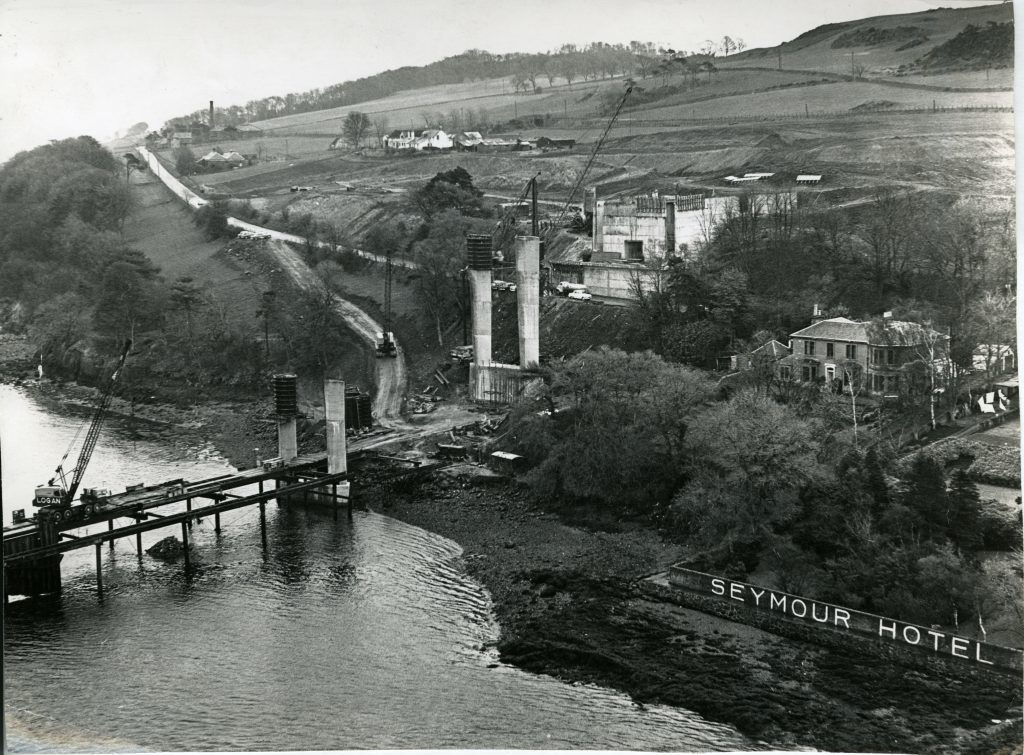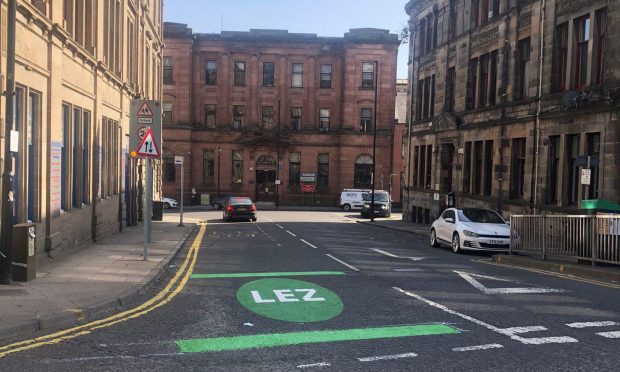As the Tay Road Bridge celebrates its 50th anniversary, Michael Alexander visits the command centre in Dundee to meet some of those responsible for keeping the bridge in good working order.
From his vantage point in the control room high above the Dundee side of the Tay Road Bridge, operational supervisor Alan Delpippo has the best view in the house – not just of the bridge itself, but of the entire £1 billion waterfront development taking shape before him.
“We’ve seen a lot of change. We’ve seen Tayside House coming down and now the V&A going up. It’s quite a good view!” smiles the 52-year-old who has worked at the Tay Road Bridge for 15 years.
As one of several operational supervisors who cover shifts 24/7, Alan, is at the front line of the day-to-day running of the bridge from keeping it open to dealing with any accidents, emergencies or breakdowns.
With panoramic views, it’s the ideal vantage point to keep a watch on the 27,000 vehicles which cross the 2.4 km bridge each day or for any emergency incidents involving pedestrians.
It’s also the hub for monitoring 16 CCTV cameras which help keep traffic moving, allows maintenance workers to access two gantries under the carriageway, and monitors wind speeds which can have a crucial impact on the bridge operation.
It tends to be gusts which are the problem, says Alan. For example, double decker buses are banned when wind speeds reach 45mph. At 60mph the walkway is closed. And at 80mph the bridge is closed completely.
The highest ever recorded wind speed was 110.3 mph in 2002.
The supervisor controls electronic signage stationed in Fife and Dundee which gives early warnings to motorists of any restrictions. He also updates social media and keeps in touch with Traffic Scotland.
Yet despite the illumination of advisory wind speed restriction signs, Alan says problems can persist when a minority of lorry drivers flout the warnings.
“The wind from the west is our worst,” he says, “and it can vary in strength across the bridge.
“Before the abolition of the tolls we used to turn the vehicles at the other end. Nowadays Health and Safety dictates we can’t turn people away so the signs are there instead.
“The police will take a dim view of anybody crossing the bridge against the restriction advice that we provide. If a vehicle crosses when it says they shouldn’t cross, they can get charged. The insurance company might not pay out. The driver might lose his job – there are a lot of scenarios. Yet some people always think they know best and decide to cross.”
Another important aspect of the operational supervisor’s job is regular contact with the emergency services, especially the police, about any incidents, including potential suicide attempts by vulnerable persons.
Emergencies
The fire and ambulance services also let the control room know in advance if they have any crews who need to get quickly to Fife or Dundee.
For bridge manager Alan Hutchison, who has overall responsibility for the management and safe operation of the bridge and is accountable to the Tay Road Bridge Joint Board (TRBJB) for general maintenance, he knows he is doing his job properly when the bridge operates smoothly and the public do not even think about it being there.
The Sheffield-born 44-year-old, who graduated from Dundee’s Abertay University in 1995 with a degree in civil engineering, has had a lifelong interest in the crossing. With his parents originally from Perth, the family used to visit relatives in Dundee when he was a child. But 2.5 years after taking up the reins, he reveals he could never have imagined as a child that one day he would be managing the structure.
“It’s odd I suppose. I took it for granted then. I thought it had always been there. But I can fully appreciate the benefits that it brings. It’s opened up the whole area economically and socially. I’m proud to manage it actually,” says the former Dundee City Council engineer whose previous projects included being part of the design team for Dundee’s new Olympia Leisure Centre.
When the bridge first opened in 1966, replacing the Fifie ferries, tolls were introduced with different categories for the 6000 vehicles that then crossed each day. The charges were introduced to pay back the loan taken out to build the bridge and to pay for on-going costs such as maintenance. This meant the bridge was entirely self-sufficient.
History was made in 2007 when the new Scottish Government passed legislation – backed by this newspaper – to scrap the then 80p tolls, treating the bridge like any other road in the country paid for through the public purse.
The bridge’s total grant from Transport Scotland is now £1.75 million per year. Every quarter the bridge manager meets with TRBJB members – including councillors from Dundee, Fife and Angus councils – to discuss the needs of the bridge and then take any specifics to Transport Scotland for approval.
Alan says that for being 50 years old, the Tay Road Bridge is standing up very well.
And a lot of this is down to the vision of the designers and what those behind it wanted to achieve.
“It’s what we would call a nice robust bridge I suppose,” says the bridge manager.
“It was different from the other bridges that were being built at the time. The Forth Road Bridge was a suspension bridge. But they moved away from that here due to the length – 2.4km. The span of the river that they needed to cross dictated the construction, and the location was dictated by the geology. It’s drilled deep into the bedrock. There was an alternative location further upstream but costs for that were higher and there was a will at the time they wanted the bridge into Dundee centre.”
Bridges are normally designed for a 120 year lifespan. And Alan says that so long as the bridge is well maintained and looked after, there’s no reason why it can’t “go on and on”.
This is a sentiment shared by maintenance manager Bill Angus, 61, who has worked on the bridge for 30 years. During that time he has overseen significant investment including expansion joint replacement, strengthening, resurfacing and cathodic protection – a system which uses the science of electrons to protect the bridge’s 43 support columns from the potentially harmful effects of salt water.
“It’s a competent design in that it’s not close to its limits,” he says, his office wall covered by a giant schematic of the bridge and his shelves filled with folders on everything from concrete coating notes to steel bridge assessment design.
“A lot of modern bridges are designed close to their limits to keep the costs down. They don’t have much resilience. This was a robust design. They didn’t cut corners. It was competent. Not overly heavy like the Forth Railway Bridge which was probably five or six times stronger than it needs to be.
“The significant on-going investment in the bridge is crucial.”
Fiona Fraser, 58, the operational manager responsible for five supervisors and 10 bridge officers, has been working with Heritage Lottery Funded curator Catriona Baird to pull together a programme of events to mark the 50th anniversary of the bridge.
For the anniversary itself – Thursday August 18 – bunting and flags have been put out to replicate the bridge as it was at the opening. The foghorn in the middle of the bridge will also be set off at 12.30pm which is the time the Queen Mother actually arrived to pronounce the opening on August 18, 1966.
Then on Sunday August 21 a series of special free fun day events will take place, centred on Dundee’s Slessor Gardens. There will be boat trips and vintage cars coming over the bridge, as well as 30 Harley Davidson bikers and Vespa scooters. Vintage buses will bring people over from Tayport and Newport. A number of survivors involved in the opening of the bridge in 1966 have been invited. Their memories will be featured in a mobile road show which will also display in Fife.
Fiona has her own memories of life before and after the bridge. As a child who moved to Dundee from Bonnybridge, she used to travel on the Fifie with her dad to visit relatives in Cupar. She particularly remembers the “excitement” of being on the ferry. When the bridge opened, her mum used to wake her as they approached the bridge so that she could see the “fairy lights” of Dundee.
What she has particularly enjoyed in recent months, however, is the collation of human stories about how the bridge changed the socio-economic fabric of life in Dundee and north Fife.
She adds: “I spoke to one 89-year-old in Newport and he was speaking about life before the road bridge. He said: ‘Aye, I used to court a lassie in Dundee. If you missed the Fifie and you missed the last train you couldn’t get home. We’d walk over the railway bridge. If the guard saw you he’d shoo you back. So what we did three-quarters of the way along is you turned around and walked backwards so that if the guard saw you he thought you were going in to Dundee,’ Fiona laughs. “And he wasn’t the only one who did that!”
Mr Hutchison adds: “The events are more to share and give an opportunity for the region – both Fife, Dundee and Angus – to get together and celebrate the bridge and perhaps just pause for a moment or two and appreciate we have this marvellous bridge and that engineers can really make a difference to society socially and economically. We hope as many people as possible will get involved.”
This was echoed by Tay Road Bridge Joint Board chairman Fife councillor Maggie Taylor who said she was “delighted” the commemorations were taking place. She had particularly enjoyed meeting some of those former employees who were involved in the construction of the bridge.
malexander@thecourier.co.uk





















